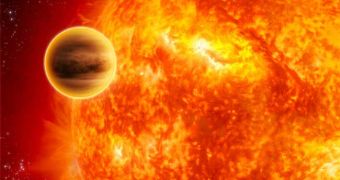So far, our astronomers have managed to discover about 300 extrasolar planets, the majority of which they named “Hot Jupiters,” since they resemble the planet of our solar system pretty much in size and composition. The main difference, though, is that the alien worlds are much closer to their star than Jupiter is to the Sun, which causes some of them to face temperatures of approximately 1,600°C (3,000°F). This is not a direct observation, though, since they are so far from our planet that direct study is not possible, but rather facts deduced from their brightness and rotation behavior, compared with the Earth's.
Observations made via the Spitzer Space Telescope showed that the dark side of HD 189733b, one of the hot Jupiters, for example, registers temperatures of about 700°C (1,300°F). Computer models developed by experts showed that this kind of planets may be “tidally locked” by their stars, meaning that they always face the star with the same side of their body, while the other is constantly wallowed in darkness. This could explain how the powerful weather phenomenons occur on their surface.
According to the simulations developed by Adam Showman and his team from the University of Arizona, extremely powerful and fast winds (jet streams) circulate at speeds of 11,000 km/h (7,000 mph) on the planet's surface, performing the heat exchange between the hotter and the colder regions. “You're talking about winds fast enough to carry you in a hot air balloon from San Francisco to New York in 25 minutes,” explains Showman. This kind of jet stream-type activity is also found on Earth or on Jupiter, but on a much smaller scale, both in terms of velocity and area affected.
“The basic chemical and physical processes are similar, but all the details are different,” claims Mr. Showman. “These planets are so close to their stars, so their temperatures are much higher and winds speeds are much higher. These types of jet streams are something that doesn't exist in our solar system. Hot Jupiters are pretty crazy places,” he adds. “Expect supersonic winds and dayside temperatures hot enough to melt lead and rocks. Only problem is, if you tried to visit, you'd be fried to a crisp before you could enjoy the view.”

 14 DAY TRIAL //
14 DAY TRIAL //